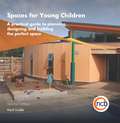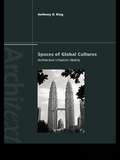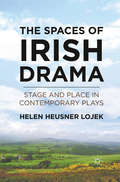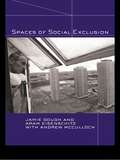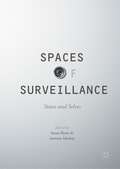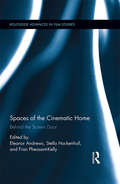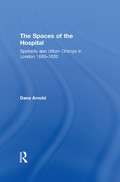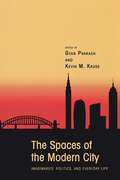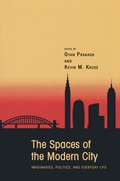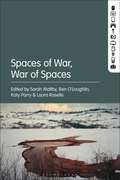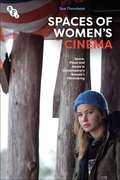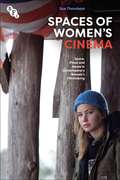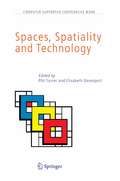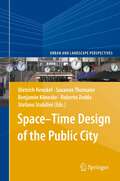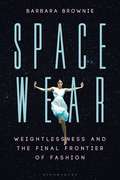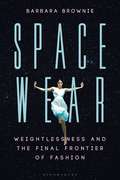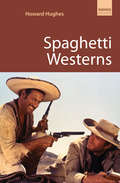- Table View
- List View
Spaces for Shaping the Nation: National Museums and National Galleries in Nineteenth-Century Europe (Edition Museum #73)
by Marina Beck Christina StrunckAs spaces of knowledge, the national museums and galleries of nineteenth-century Europe played an important role both in the shaping of nation-states and the education of their populations. In this context, such institutions sought to convey the history of the people, for example by displaying pictorial cycles of important scenes from their history, exhibiting objects associated with certain formative events, or arraying period rooms to promote a specific impression of the past. The contributions to this volume examine the purposes and educational strategies of national museums and national galleries via case studies from Denmark, France, Germany, Great Britain, Italy, the Netherlands, Poland, Sweden, and Switzerland.
Spaces for Young Children, Second Edition: A practical guide to planning, designing and building the perfect space (PDF)
by Mark DudekMany childcare practitioners understand the importance of architecture in ensuring good provision for young children and their families. Whether making minor modifications to an existing facility, embarking on major improvements, or a new construction, this book will empower early years professionals to work with building professionals to create the best space for young children. It addresses the big things, such as efficient heating and ventilation, but more importantly suggests the smaller features that can provide an educationally stimulating environment. Spaces for Young Children looks at: · why architecture is important · a history of childcare environments · designing space for young children · details that enhance play · risk and challenge within a safe environment · the importance of outdoor play · the process of design, procurement and construction. Good architecture combines the practical with a sense of delight. A building can help to make children's experience of their early years care secure and inspiring. Drawing on experience from the UK and Europe, this second edition aims to ensure that advances in children's architecture will be well informed. It has been revised throughout and includes an overview of legal compliance, consulting with children, building for communities, local involvement and achieving high quality builds with small budgets.
Spaces of Care - Confronting Colonial Afterlives in European Ethnographic Museums (Edition Museum #77)
by Wayne Modest Claudia AugustatAlarming environmental shifts and disasters have raised public awareness and anxieties regarding the future of the planet. While planetary in scale, the negative effects of this global crisis are distributed unequally, affecting some of the already most fragile communities most intensely, thus contributing to rising global inequality. The pairing of environmental crises and a sense of inadequacy facing hitherto celebrated models of citizenry informs a current spirit of the times. The contributors to this volume place ethnographic or world cultures museums at the centre of these debates - these museums have been embroiled in longstanding debates about their histories, collections, and practices in relation to the colonial past.
Spaces of Commemoration and Communication: A Novel Approach at the Mauthausen Memorial Visitor Center (Edition Museum #75)
by Stefan Sonvilla-WeissIn times of resurgence of ultra-nationalistic and xenophobic tendencies across Europe, education and awareness-raising for all age groups about the history of the Holocaust are of paramount for agency and civil engagement. Stefan Sonvilla-Weiss examines commemorative culture and its transformation towards interactive and participatory experiences through a novel form of visitor engagement at the Mauthausen memorial visiting center. This unique space from an arts-based and media research project builds on human-centered design and individual and collective experiences of contributing to a living memory culture.
Spaces of Global Cultures: Architecture, Urbanism, Identity (Architext)
by Anthony KingThis book brings together a series of new and historical case studies to show how different phases of globalization are transforming the built environment. Taking a broad interdisciplinary approach, the author draws on sociological, geographical, cultural and postcolonial studies to provide a critical account of the development of three key concepts: global culture, post colonialism, and modernity. Subsequent case studies examine how global economic, political and cultural forces shape the forms of architectural and urban modernity in globalized suburbs and spaces in major cities worldwide. The first book to combine global and postcolonial theoretical approaches to the built environment and to illustrate these with examples, Spaces of Global Cultures argues for a more historical and interdisciplinary understanding of globalization: one that places material space and the built environment at the centre and calls for new theories to address new conditions.
Spaces of Global Cultures: Architecture, Urbanism, Identity (Architext)
by Anthony KingThis book brings together a series of new and historical case studies to show how different phases of globalization are transforming the built environment. Taking a broad interdisciplinary approach, the author draws on sociological, geographical, cultural and postcolonial studies to provide a critical account of the development of three key concepts: global culture, post colonialism, and modernity. Subsequent case studies examine how global economic, political and cultural forces shape the forms of architectural and urban modernity in globalized suburbs and spaces in major cities worldwide. The first book to combine global and postcolonial theoretical approaches to the built environment and to illustrate these with examples, Spaces of Global Cultures argues for a more historical and interdisciplinary understanding of globalization: one that places material space and the built environment at the centre and calls for new theories to address new conditions.
The Spaces of Irish Drama: Stage and Place in Contemporary Plays
by H. LojekLojek provides extensive analysis of space in plays by living Irish playwrights, applying practical understandings of staging and the insights of geographers and spatial theorists to drama in an era increasingly aware of space.
Spaces of Social Exclusion
by Jamie Gough Aram Eisenschitz Andrew McCullochTo varying extents in developed countries a minority of the population suffers from deprivation. Britain’s Labour government in particular has sought to deal with this through the notion of 'social exclusion', and similar ideas have been developed in other countries. This important text explores the various forms of this contemporary economic and social disadvantage and, in particular, investigates its social and spatial causes and the role of space in policies addressing disadvantage. Arranged in three distinct parts, it: introduces contemporary and historical conceptualizations of social exclusion and poverty analyzes social exclusion’s origins by examining the different spheres of disadvantage and their relations discusses strategies for overcoming social exclusion, and analyzes policy ideas from across the political spectrum. This book is the first to systematically analyze the role of geography in poverty and social exclusion, and deals with the roles of ‘globalization’ and localism. Though its main focus is Britain, it investigates similarities and differences in other developed countries. Spaces of Social Exclusion is a key text for researchers and students throughout the social sciences, social policy, human geography and urban studies, as well as policy makers and practitioners in social and urban policy.
Spaces of Social Exclusion
by Jamie Gough Aram Eisenschitz Andrew McCullochTo varying extents in developed countries a minority of the population suffers from deprivation. Britain’s Labour government in particular has sought to deal with this through the notion of 'social exclusion', and similar ideas have been developed in other countries. This important text explores the various forms of this contemporary economic and social disadvantage and, in particular, investigates its social and spatial causes and the role of space in policies addressing disadvantage. Arranged in three distinct parts, it: introduces contemporary and historical conceptualizations of social exclusion and poverty analyzes social exclusion’s origins by examining the different spheres of disadvantage and their relations discusses strategies for overcoming social exclusion, and analyzes policy ideas from across the political spectrum. This book is the first to systematically analyze the role of geography in poverty and social exclusion, and deals with the roles of ‘globalization’ and localism. Though its main focus is Britain, it investigates similarities and differences in other developed countries. Spaces of Social Exclusion is a key text for researchers and students throughout the social sciences, social policy, human geography and urban studies, as well as policy makers and practitioners in social and urban policy.
Spaces of Surveillance: States and Selves
by Susan Flynn Antonia MackayIn a world of ubiquitous surveillance, watching and being watched are the salient features of the lives depicted in many of our cultural productions. This collection examines surveillance as it is portrayed in art, literature, film and popular culture, and makes the connection between our sense of ‘self’ and what is ‘seen’. In our post-panoptical world which purports to proffer freedom of movement, technology notes our movements and habits at every turn. Surveillance seeps out from businesses and power structures to blur the lines of security and confidentiality. This unsettling loss of privacy plays out in contemporary narratives, where the ‘selves’ we create are troubled by surveillance. This collection will appeal to scholars of media and cultural studies, contemporary literature, film and art and American studies.
Spaces of the Cinematic Home: Behind the Screen Door (Routledge Advances in Film Studies)
by Stella Hockenhull Eleanor Andrews Fran Pheasant-KellyThis book examines the ways in which the house appears in films and the modes by which it moves beyond being merely a backdrop for action. Specifically, it explores the ways that domestic spaces carry inherent connotations that filmmakers exploit to enhance meanings and pleasures within film. Rather than simply examining the representation of the house as national symbol, auteur trait, or in terms of genre, contributors study various rooms in the domestic sphere from an assortment of time periods and from a diversity of national cinemas—from interior spaces in ancient Rome to the Chinese kitchen, from the animated house to the metaphor of the armchair in film noir.
Spaces of the Cinematic Home: Behind the Screen Door (Routledge Advances in Film Studies #42)
by Stella Hockenhull Eleanor Andrews Fran Pheasant-KellyThis book examines the ways in which the house appears in films and the modes by which it moves beyond being merely a backdrop for action. Specifically, it explores the ways that domestic spaces carry inherent connotations that filmmakers exploit to enhance meanings and pleasures within film. Rather than simply examining the representation of the house as national symbol, auteur trait, or in terms of genre, contributors study various rooms in the domestic sphere from an assortment of time periods and from a diversity of national cinemas—from interior spaces in ancient Rome to the Chinese kitchen, from the animated house to the metaphor of the armchair in film noir.
The Spaces of the Hospital: Spatiality and Urban Change in London 1680-1820
by Dana ArnoldThe Spaces of the Hospital examines how hospitals operated as a complex category of social, urban and architectural space in London from 1680 to 1820. This period witnessed the transformation of the city into a modern metropolis. The hospital was very much part of this process and its spaces, both interior and exterior, help us to understand these changes in terms of spatiality and spatial practices. Exploring the hospital through a series of thematic case studies, Dana Arnold presents a theoretically refined reading of how these institutions both functioned as internal discrete locations and interacted with the metropolis. Examples range from the grand royal military hospital, those concerned with the destitute and the insane and the new cultural phenomenon of the voluntary hospital. This engaging book makes an important contribution to our understanding of urban space and of London, uniquely examining how different theoretical paradigms reveal parallel readings of these remarkable hospital buildings.
The Spaces of the Hospital: Spatiality and Urban Change in London 1680-1820
by Dana ArnoldThe Spaces of the Hospital examines how hospitals operated as a complex category of social, urban and architectural space in London from 1680 to 1820. This period witnessed the transformation of the city into a modern metropolis. The hospital was very much part of this process and its spaces, both interior and exterior, help us to understand these changes in terms of spatiality and spatial practices. Exploring the hospital through a series of thematic case studies, Dana Arnold presents a theoretically refined reading of how these institutions both functioned as internal discrete locations and interacted with the metropolis. Examples range from the grand royal military hospital, those concerned with the destitute and the insane and the new cultural phenomenon of the voluntary hospital. This engaging book makes an important contribution to our understanding of urban space and of London, uniquely examining how different theoretical paradigms reveal parallel readings of these remarkable hospital buildings.
The Spaces of the Modern City: Imaginaries, Politics, and Everyday Life
by Gyan Prakash Kevin M. KruseBy United Nations estimates, 60 percent of the world's population will be urban by 2030. With the increasing speed of urbanization, especially in the developing world, scholars are now rethinking standard concepts and histories of modern cities. The Spaces of the Modern City historicizes the contemporary discussion of urbanism, highlighting the local and global breadth of the city landscape. This interdisciplinary collection examines how the city develops in the interactions of space and imagination. The essays focus on issues such as street design in Vienna, the motion picture industry in Los Angeles, architecture in Marseilles and Algiers, and the kaleidoscopic paradox of post-apartheid Johannesburg. They explore the nature of spatial politics, examining the disparate worlds of eighteenth-century Baghdad, nineteenth-century Morelia, Cold War-era West Berlin, and postwar Los Angeles. They also show the meaning of everyday spaces to urban life, illuminating issues such as crime in metropolitan London, youth culture in Dakar, "memory projects" in Tokyo, and Bombay cinema. Informed by a range of theoretical writings, this collection offers a fresh and truly global perspective on the nature of the modern city. The contributors are Sheila Crane, Belinda Davis, Mamadou Diouf, Philip J. Ethington, David Frisby, Christina M. Jiménez, Dina Rizk Khoury, Ranjani Mazumdar, Frank Mort, Martin Murray, Jordan Sand, and Sarah Schrank.
The Spaces of the Modern City: Imaginaries, Politics, and Everyday Life (Publications in Partnership with the Shelby Cullom Davis Center at Princeton University #2)
by Gyan Prakash Kevin M. KruseBy United Nations estimates, 60 percent of the world's population will be urban by 2030. With the increasing speed of urbanization, especially in the developing world, scholars are now rethinking standard concepts and histories of modern cities. The Spaces of the Modern City historicizes the contemporary discussion of urbanism, highlighting the local and global breadth of the city landscape. This interdisciplinary collection examines how the city develops in the interactions of space and imagination. The essays focus on issues such as street design in Vienna, the motion picture industry in Los Angeles, architecture in Marseilles and Algiers, and the kaleidoscopic paradox of post-apartheid Johannesburg. They explore the nature of spatial politics, examining the disparate worlds of eighteenth-century Baghdad, nineteenth-century Morelia, Cold War-era West Berlin, and postwar Los Angeles. They also show the meaning of everyday spaces to urban life, illuminating issues such as crime in metropolitan London, youth culture in Dakar, "memory projects" in Tokyo, and Bombay cinema. Informed by a range of theoretical writings, this collection offers a fresh and truly global perspective on the nature of the modern city. The contributors are Sheila Crane, Belinda Davis, Mamadou Diouf, Philip J. Ethington, David Frisby, Christina M. Jiménez, Dina Rizk Khoury, Ranjani Mazumdar, Frank Mort, Martin Murray, Jordan Sand, and Sarah Schrank.
Spaces of War, War of Spaces
by Laura Roselle Sarah Maltby Katy Parry Ben O’LoughlinSpaces of War, War of Spaces provides a rich, international and multi-disciplinary engagement with the convergence of war and media through the conceptual lens of 'space'. 'Space' offers a profound, challenging and original framework through which notions of communication, embodiment, enactment, memory and power are interrogated not only in terms of how media spaces (traditional, digital, cultural, aesthetic, embodied, mnemonic) transform the conduct, outcomes and consequences of war for all involved, but how 'war' actors (political, military, survivors, victims) recreate space in a manner that is transformative across political, social, cultural and personal spheres. Foregrounding the work of artists, activists and practitioners alongside more traditional scholarly approaches Spaces of War, War of Spaces engages with the 'messiness' of war and media through the convergence of practice and theory, where showing and embodying is made explicit.
Spaces of War, War of Spaces
Spaces of War, War of Spaces provides a rich, international and multi-disciplinary engagement with the convergence of war and media through the conceptual lens of 'space'. 'Space' offers a profound, challenging and original framework through which notions of communication, embodiment, enactment, memory and power are interrogated not only in terms of how media spaces (traditional, digital, cultural, aesthetic, embodied, mnemonic) transform the conduct, outcomes and consequences of war for all involved, but how 'war' actors (political, military, survivors, victims) recreate space in a manner that is transformative across political, social, cultural and personal spheres. Foregrounding the work of artists, activists and practitioners alongside more traditional scholarly approaches Spaces of War, War of Spaces engages with the 'messiness' of war and media through the convergence of practice and theory, where showing and embodying is made explicit.
Spaces of Women's Cinema: Space, Place and Genre in Contemporary Women’s Filmmaking
by Sue ThornhamSue Thornham explores issues of space, place, time and gender in feminist filmmaking through an examination of a wide range of films by contemporary women filmmakers, ranging from the avant-garde to mainstream Hollywood. Beginning from questions about space itself and the way it has been gendered, she asks how representation functions in relation to space and time, and how this, too, is gendered, before moving to an exploration of how such questions might be considered in relation to women's filmmaking. In sections dealing with spaces from wilderness to city, she analyses in detail how these issues have been dealt with by women filmmakers, addressing the work of filmmakers such as Jane Campion, Kathryn Bigelow, Julie Dash, Maggie Greenwald, Patricia Rozema and Carol Morley, and films including 'An Angel at My Table' (1990), 'Daughters of the Dust' (1991) 'The Ballad of Little Jo' (1993), 'Winter's Bone' (2010), 'Zero Dark Thirty' (2012) and 'The Falling' (2014).
Spaces of Women's Cinema: Space, Place and Genre in Contemporary Women’s Filmmaking
by Sue ThornhamSue Thornham explores issues of space, place, time and gender in feminist filmmaking through an examination of a wide range of films by contemporary women filmmakers, ranging from the avant-garde to mainstream Hollywood. Beginning from questions about space itself and the way it has been gendered, she asks how representation functions in relation to space and time, and how this, too, is gendered, before moving to an exploration of how such questions might be considered in relation to women's filmmaking. In sections dealing with spaces from wilderness to city, she analyses in detail how these issues have been dealt with by women filmmakers, addressing the work of filmmakers such as Jane Campion, Kathryn Bigelow, Julie Dash, Maggie Greenwald, Patricia Rozema and Carol Morley, and films including 'An Angel at My Table' (1990), 'Daughters of the Dust' (1991) 'The Ballad of Little Jo' (1993), 'Winter's Bone' (2010), 'Zero Dark Thirty' (2012) and 'The Falling' (2014).
Spaces, Spatiality and Technology (Computer Supported Cooperative Work #5)
by Phil Turner Elisabeth Davenportseparated by the exigencies of the design life cycle into another compartment, that makes invisible the (prior) technical work of engineers that is not directly pertinent to the application work of practitioners. More recently (and notably after the work of Greisemer and Star) the black box has been opened and infrastructure has been discussed in terms of the social relations of an extended group of actors that includes developers. Ethical and political issues are involved (cf f accountable computing). Writing broadly within this context, Day (chapter 11) proposes that the concept of 'surface' can assist us to explore space as the product of 'power and the affective and expressive role for materials', rather than the background to this. Surfaces are the 'variously textured…sites for mixtures between bodies', and are thus the 'sites for events'. The notions of 'folding' and 'foldability' and 'unfolding' are discussed at length, as metaphors that account for the interactions of bodies in space across time. Some of the contributors to this volume focus on ways in which we may experience multiple infrastructures. Dix and his colleagues, for example, in chapter 12 explore a complex of models - of spatial context, of 'mixed reality boundaries' and of human spatial understanding across a number of field projects that make up the Equator project to explain the ways in which co-existing multiple spaces are experienced.
Space–Time Design of the Public City (Urban and Landscape Perspectives #15)
by Dietrich Henckel, Susanne Thomaier, Benjamin Könecke, Roberto Zedda and Stefano StabiliniTime has become an increasingly important topic in urban studies and urban planning. The spatial-temporal interplay is not only of relevance for the theory of urban development and urban politics, but also for urban planning and governance. The space-time approach focuses on the human being with its various habits and routines in the city. Understanding and taking those habits into account in urban planning and public policies offers a new way to improve the quality of life in our cities. Adapting the supply and accessibility of public spaces and services to the inhabitants’ space-time needs calls for an integrated approach to the physical design of urban space and to the organization of cities. In the last two decades the body of practical and theoretical work on urban space-time topics has grown substantially. The book offers a state of the art overview of the theoretical reasoning, the development of new analytical tools, and practical experience of the space-time design of public cities in major European countries. The contributions were written by academics and practitioners from various fields exploring space-time research and planning.
Spacewear: Weightlessness and the Final Frontier of Fashion
by Barbara BrownieToday, we are living in the New Space Age, where mass commercial space travel is almost within our grasp. This otherworldly possibility has opened up new cultural images of space, both real and fictional, and has caused fashion design and spacesuit engineering to intersect in new, exciting ways. Spacewear traverses this uncharted territory by exploring the changing imagination of space in fashion-and fashion in space-from the first Space Age to the 21st century. Exploring how space travel has stylistically and technologically framed fashion design on earth and how we need to revisit established design practices for the weightless environment, Spacewear connects the catwalk and the space station.This book draws together speculative fantasies in sci-fi films such as Star Trek and 2001: A Space Odyssey, with the engineered spacesuits Biosuit, and the NASA Z-2 and with catwalk interpretations by the likes of Alexander McQueen, Hussein Chalayan, André Courrèges, and Iris van Herpen. While the development of commercial space agencies has led to new concerns for style in garments for outer space that re-think fundamental design principles such as drape, high fashion has experimented with new possibilities for weightlessness that extend far beyond the 1960s vision of Space Age metallic fabrics and helmet-style headwear. Brownie takes the reader on a fascinating journey from fantasy to function and to form, deepening our understanding of this new category of fashion that is prompting new approaches to garment design and construction both on earth and in outer space.
Spacewear: Weightlessness and the Final Frontier of Fashion
by Barbara BrownieToday, we are living in the New Space Age, where mass commercial space travel is almost within our grasp. This otherworldly possibility has opened up new cultural images of space, both real and fictional, and has caused fashion design and spacesuit engineering to intersect in new, exciting ways. Spacewear traverses this uncharted territory by exploring the changing imagination of space in fashion-and fashion in space-from the first Space Age to the 21st century. Exploring how space travel has stylistically and technologically framed fashion design on earth and how we need to revisit established design practices for the weightless environment, Spacewear connects the catwalk and the space station.This book draws together speculative fantasies in sci-fi films such as Star Trek and 2001: A Space Odyssey, with the engineered spacesuits Biosuit, and the NASA Z-2 and with catwalk interpretations by the likes of Alexander McQueen, Hussein Chalayan, André Courrèges, and Iris van Herpen. While the development of commercial space agencies has led to new concerns for style in garments for outer space that re-think fundamental design principles such as drape, high fashion has experimented with new possibilities for weightlessness that extend far beyond the 1960s vision of Space Age metallic fabrics and helmet-style headwear. Brownie takes the reader on a fascinating journey from fantasy to function and to form, deepening our understanding of this new category of fashion that is prompting new approaches to garment design and construction both on earth and in outer space.
Spaghetti Westerns: The Filmgoers' Guide To Spaghetti Westerns (Pocket Essentials Ser.)
by Howard HughesOnce upon a time in the West, Clint Eastwood earned himself a fistful of dollars - and instant stardom- when his 'Man With No Name' rode into town. In the mid-sixties Eastwood's Dollars trilogy with director Sergio Leone - A Fistful of Dollars, For a Few Dollars More and The Good, the Bad and the Ugly - gunned down all opposition at the world box office and created a visceral new brand of anti-Western, dubbed 'Spaghetti Westerns' by critics bemused by the films' popularity. Spaghetti Westerns' cynical morality tales of revenge, betrayal and mercenary avarice were filmed in the desert badlands of Almeria, Southern Spain. Eastwood's immortal 'Man With No Name' is the enduring symbol of the genre, but Leone and Eastwood weren't the first, nor the most prolific filmmakers to make Spaghetti Westerns, and this Kamera Guide reviews the best of a wild bunch, including cult classics Django, The Big Gundown, They Call Me Trinity and Navajo Joe. Spaghetti Westerns examines the genre, from the most famous offerings- Once Upon a Time in the West and the Dollars trilogy- to offbeat fare, such as Cemetery Without Crosses and Django Kill. It charts the Spaghetti Western careers of Lee Van Cleef, Terence Hill and Klaus Kinski as they rode to international stardom, and appraises maestro Ennio Morricone's groundbreaking Western scores. In addition to an introduction to the genre, 34 of the best Spaghetti Westerns are analysed in detail, illustrated with rare colour posters and stills. There is also a multi- media reference section, listing essential books, websites, DVD releases and soundtracks.

